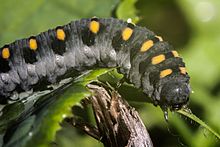Symphyta
The Symphyta (Symphyta) are a suborder of Hymenoptera, probably paraphyletic, that includes the most primitive members of the order. They are known by the common name sawflies or saw-carrying flies due to the appearance of the ovipositor that resembles a saw blade. Females use the ovipositor to cut the plants where they will lay their eggs; some species, however, have slender ovipositors for boring deep holes in wood.
The symphytes differ from the rest of the Hymenoptera (Apocrita) because they lack the "wasp waist" (close connection between the abdomen and thorax).
Adults, except those of the Cephidae family, have structures on the underside of the wing that help support them when the insect is at rest. These structures are absent in members of the suborder Apocrita, and are located behind the scutellum on the thorax.

Description

Many species of symphytes have maintained their ancestral characteristics over time, especially their herbivorous habits, wing venation and abdomen without modifications, where the first two segments are similar to the following. The absence of a "wasp waist" distinguishes symphyths from other members of Hymenoptera. Some have Batesian mimicry with coloration similar to that of bees and wasps and with an ovipositor that looks like a stinger, although they are incapable of sting. Most are weak in flight. Symphytes vary in size. One of the largest is Urocerus gigas, which can reach 20 mm in length. The largest known fossil symphyte is Hoplitolyda duolunica from the Mesozoic, with a length of 55 mm and a wingspan of 92 mm. The smallest species reach 2.5 mm.

The heads of symphytes vary in size, shape and robustness, as well as the position of the eyes and antennae. The head is hypognathous, meaning that the mouthparts are directed downwards. They can direct them forward when they turn their head in a pendulum shape. The antennae have from 6 segments in the family Accorduleceridae to 30 in Pamphiliidae.
Biological cycle
Symphite larvae resemble butterfly and moth caterpillars (they are called eruciformes larvae). Several morphological features distinguish them from them. In addition to the three pairs of thoracic legs that both types of larvae have, the caterpillars have 5 pairs of false legs in abdominal segments 3 to 6 and 10 (except the Geometridae caterpillars that have only one or two pairs of false legs). Symphith larvae generally have 8 pairs in abdominal segments 2 to 8 and 10. Another difference is that the false legs of symphyth larvae lack small hooks like those of caterpillars. The false legs gradually disappear as the time for pupation approaches and this makes differentiation more difficult. Symphith larvae have a single pair of tiny eyes, while caterpillars have four to six eyes on each side of the head.

Symphite larvae are herbivorous, developing on a wide variety of plants, being quite specific in the type of plant used as food. The larvae of a few families, for example Orussidae, lack eyes and even legs or have them greatly reduced. Such larvae make tunnels in plant tissue and even wood. The larvae of many species are strikingly colored, black and white or white and yellow. It is a case of aposematism, warning predators of its toxicity.
Generally there is only one generation per year. They spend the winter as a mature larva or pupa wrapped in a cocoon or in some sheltered place; those that are external dining rooms, on the ground and the internal ones, inside the plant. Some species, especially the largest ones, need more than a year to complete their life cycle. Adults are very short-lived, some live 7 to 9 days and do not need to feed. They feed on an immense variety of sources, fungi, plants or other insects; sap, pollen or nectar, decomposing material, etc. The mouthparts are adapted to all types of feeding, from crushing jaws to tubes for drinking nectar or sap.
Biological cycle of Cladius difformis
Larva
Pupa, dorsal view
Pupa, ventral view
Female
Macho
Distribution
Symphites are widely distributed throughout the world. The most numerous family, Tenthredinidae, with around 5000 species, is found on all continents except Antarctica and New Zealand; They are very rare in Australia. They are most abundant and diverse in the temperate regions of the northern hemisphere. The second family in number of species, Argidae, with around 800 species, is also worldwide distributed, but is more common in tropical regions, especially in Africa, where they feed on herbaceous angiosperms. Of the remaining families, Blasticotomidae and Megalodontidae are Palearctic; Xyelidae, Pamphilidae, Diprionidae, Cimbicidae and Cephidae are Holarctic; while Siricidae is mainly Holarctic with some tropical species. The parasitic family Orussidae has a worldwide distribution, most common in tropical and subtropical regions. The family of wood borers, Xiphydriidae, has a worldwide distribution, but most live in subtropical areas of Asia.
Economic importance


Symphite wasps cause serious forest damage. For example, species of Diprionidae, such as Diprion pini and Neodiprion sertifer destroy pine groves in regions of Scandinavia. In cases where the trees are large or the larval populations They are low, the damage is minimal.
They also cause serious problems for horticulture. Certain species specialize on certain plants, for example the larvae of Rhadinoceraea micans feed on lilies including the yellow lily (Iris pseudacorus). Symphytic rose wasps, Arge pagana and Arge ochropus devour the rose bushes.
The giant syrice, Urocerus gigas, has a long ovipositor and with its black and yellow coloring is a good mimic of wasps. Despite its alarming appearance, it cannot sting because it lacks a sting. It deposits its eggs in pine trees, "fir trees" (Picea) or larches. The larvae feed on wood by opening tunnels that cause economic damage.
Various measures can be taken to combat wood wasps. The larvae can be collected by hand and placed in boiling water or kerosene, although this is not practical in plantations. Predators or parasitoids can be used as biological controls. Fumigation with insecticides such as malathion, dimethoate and carbaryl is also used.




